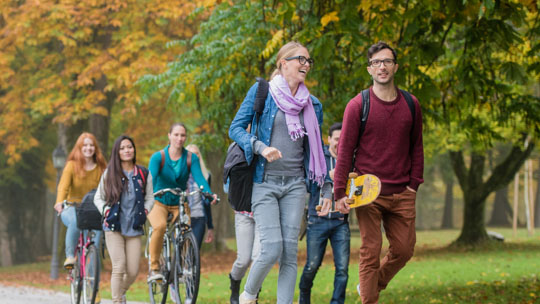Nine Unbelievable Facts About Top US Universities
American universities are, to put it simply, some of the most famous in the world. That doesn’t mean you’ll know everything about them though, as often the strangest, most interesting facts get left out of the official prospectuses. Here are some of our favorite weird and unbelievable facts about the top US universities in the QS World University Rankings® 2018.
MIT students can become fully qualified pirates
Well, sort of. Any student at Massachusetts Institute of Technology (MIT) who completes archery, fencing, sailing and pistol (or rifle) classes is eligible to receive a pirate’s license. It doesn’t give you the right to commandeer a vessel, smuggle goods or drink all the rum though.
A Stanford student has won a medal at every Olympics since 1908
Not the same student every year, obviously. Still, this is a remarkably impressive feat for the university and its athletes.
The statue of John Harvard at Harvard is actually of someone else
Nobody actually knows what John Harvard looked like, so when it was time for Daniel Chester French to make the statue which sits in Harvard Yard at the university, he used a friend’s likeness instead.
Caltech’s football team has been undefeated since 1993
But only because the university hasn’t had a football team since 1993.
The University of Chicago holds the largest scavenger hunt in the world every year
Nobody’s entirely sure why, but it’s been a university tradition since 1987. As well as items which must be found, each year’s list contains things that need to be built, performed, written, programmed, drawn, eaten, designed, painted or solved. In a word, it’s epic.
Three-quarters of Princeton alumni marry someone else who went to Princeton
And presumably they go on to produce insufferably intelligent children, who then also go to Princeton. It’s basically Prin-cest.
Cannabis was grown in the gardens of Cornell until the 1970s
Cornell University’s Plantation is home to both a weed garden and a poisonous plants garden, but we expect some students would have found its contents much more enjoyable back in the ‘70s.
Yale’s rare book library could literally kill you
Yale University goes to extraordinary lengths to look after the rare books and manuscripts stored in the Beinecke Rare Books and Manuscripts Library. If there’s ever a fire, the library will fill with a lethal, fire-suppressing gas after 30 seconds, so you haven’t got long to get out. Air is also removed from the library as part of the process, meaning you’ll suffocate to death if you decide to ignore the alarms and carry on working.
Businessman Michael Bloomberg designed Johns Hopkins’ mascot costume
Yes, way before he was earning millions of dollars, Michael Bloomberg designed, built and wore the blue jay mascot costume at Johns Hopkins University while studying here and playing lacrosse in the 1960s.
Want more content like this? Register for free site membership to get regular updates and your own personal content feed.
The best universities in the US have plenty of strange, bizarre and interesting elements that most students don’t know about. Here are some of our favorites.
6 Amazing Reasons To Study Engineering In Sweden
Sponsored by Study in Sweden
1. Forget Berlin, Stockholm is the tech capital of Europe
2. The home of the Nobel Prize - unsurprisingly - has some of the best engineering courses in the world
3. Swedish businesses are pretty big on sustainability
4. Sweden's an extremely welcoming country for international students
5. Swedes enjoy an incredible work-life balance
6. Swedish salaries are very competitive
Cover image by Magnus Liam Karlsson/imagebank.sweden.se
Want to study engineering? Find out why Sweden might be your best bet!
Three Surprising Facts Nutrition Scientists Can Agree On (And Three They Can’t)
Coffee drinkers should sleep soundly at night (if the caffeine isn’t keeping them up)
Low-fat options can be worse for your health
Half of your plate should be fruit and vegetables
However...further research is needed on the health benefits of eating organic food
Scientists are still discussing whether burnt food is actually carcinogenic
The existence of superfoods has been contested
Learn more about nutrition
Discover three things nutrition scientists can agree on and three things they can't.
What You Need to Know Before Studying in Mexico
If you’re thinking of heading abroad to study in Mexico, you’ll want to do your research beforehand. From tips on how to visit Mexico safely, to advice on transport and local customs, here’s everything important you should know before your plane leaves.
Staying safe
Crime in Mexico is one of the country’s most urgent issues, and while some news stories and statistics can be a bit disconcerting, the threat to travelers is minimal so there’s no need to let it impact your enjoyment.
You should follow these steps to keep yourself safe, most of which should really be common sense:
- Use public transport by day and private transport by night
- Don’t wear expensive jewelry, and only carry small amounts of cash
- Keep an eye on your belongings at all times when traveling
- Take care when using ATMs – don’t count your money after withdrawing it
- Avoid political demonstrations
- Don’t hail taxis from the street – call a taxi company directly
- Carry a photocopy of your passport
- Keep up to date with current affairs
As you may have heard in the news recently, Mexico is also prone to natural disasters such as hurricanes and earthquakes. You can view advice on staying safe during an earthquake here and during a hurricane here.
Staying well
To make sure you’ll stay healthy while you study in Mexico, it’s a good idea to visit your doctor a few months before traveling, to check whether you need to have any vaccinations, such as those for cholera or Hepatitis A and B. When you’re in Mexico, you should drink only bottled or boiled water, and be wary of ice in drinks if you don’t know the source. Also, if you’re studying in a high-altitude city like Mexico City, it’s possible that you’ll experience minor altitude sickness symptoms at first, as the city is 2,240m (7,349ft) above sea level. Take it easy while your body adjusts to the height, and take medication if necessary.
Languages & culture
Although Spanish is spoken by the vast majority of Mexico’s population, there are also over 60 indigenous languages spoken, with the Náhuatl and Mayan languages the most common. Of course, Mexican Spanish has its own weird and wonderful idioms and slang terms that you won’t hear elsewhere: here’s a helpful list.
More than 82 percent of the population is Roman Catholic, and many Mexicans are quite religious. Mexican people are very friendly and can be somewhat formal – it’s common to address people as señor, señora or señorita. When speaking to an elder or someone you have a professional relationship with (such as a university professor) it’s best to use the formal pronoun usted instead of the informal tú.
When greeting someone, it’s customary to make physical contact, usually with a handshake (with strangers) or a small hug and kiss on the cheek (with friends). It’s also customary to say buen provecho (bon appetit) before eating when sharing a meal together, and you should give at least a 10 percent tip in restaurants and bars.
It’s great to be familiar with important days in Mexican culture, such as Cinco de Mayo (easily remembered if you know your Spanish: May 5), which commemorates the Mexican Army's victory over the French Empire at the Battle of Puebla, on May 5 1862. Cinco de Mayo is sometimes mistaken for Mexican Independence Day, which is actually September 16. Cinco de Mayo, unlike Independence Day, is not a national holiday – but it is widely celebrated in Puebla. There’s also the famous Day of the Dead (Día de Muertos) holiday, celebrated November 1-2, in which Mexicans celebrate and remember deceased loved ones and help support their spiritual journey. It’s a colorful, exciting time, despite the usually grim subject of death, and definitely one to get involved in while you study in Mexico.
In terms of Mexican food, there’s far more to it than tacos and burritos (although we wouldn’t say no to either). Mexican food is vibrant, interesting and bold, and was named part of the Intangible Cultural Heritage of Humanity by UNESCO. Tortillas, corn and chili are three key ingredients: we hope you like chili in particular, as Mexicans like to add it to pretty much everything – including breakfast. You can read about what dishes and drinks you should try during your studies here.
Getting around
As you settle in and get used to your surroundings as you study in Mexico, you’ll probably want to travel further afield, perhaps by bus or even a domestic flight. Wherever you go, there’s a lot to see – Mexico is one of the most biodiverse countries on the planet, and is home to a significant number of UNESCO World Heritage Sites, including ancient ruins, colonial cities, and natural reserves. It’s also very beautiful – you can read more about the most beautiful places to visit in Mexico here.
If you want to travel around Mexico via bus, the country actually has a very well-developed, affordable and comfortable intercity bus system, offering different classes of service to suit your needs.
Mexico City has a large, fast metro system – like any city, you can expect this to be very busy during weekday rush hours, but it’s nonetheless very efficient, getting you to the city center far faster than a taxi would. It’s also super affordable, with a one-way ticket only costing you five pesos – the equivalent of just 25 US cents.
Want more content like this? Register for free site membership to get regular updates and your own personal content feed.
Heading to Mexico to study abroad? Find out everything you need to know to have a safe, fun experience.
An Insider's Guide on What to Do When Studying in Amsterdam
Amsterdam: the city made popular for its liberal drug regulations, cheese, bikes and plethora of sightseeing spots. Whether you’re here for one day, week or year, Amsterdam seems to have a way of getting under people’s skin. With its crooked brick buildings along the canals, great parties, open-minded people and amazing parks, this city has a lot to offer for every taste.
Sights you need to see in Amsterdam
Admittedly, no one appreciates paying to wait in long queues or standing in crowded areas. However, there are a few occasions in Amsterdam when it’s arguably worth the effort. The first of these exceptions is a boat tour around the city’s canals. This is a great way to introduce yourself to Amsterdam and the quirky buildings hugging the surrounding water. Booking a boat ride in one of the many locations around the city means you’ll have an easy chance to meet new people, have a few drinks and avoid the crazy biking scene in Amsterdam for a few hours. An alternative for those seeking more adventurous activities is to rent a kayak or a pedal boat and be your own captain.
Other exceptions to the tourist rule are Anne Frank’s house, the Van Gogh Museum and the Rijksmuseum. Whether you are a self-proclaimed history enthusiast, have read the book, or have no knowledge on the topic at all, the Anne Frank house is a must-see for all. Situated in the center of Amsterdam, the transformed museum is understandably fully booked months in advance. So, to avoid the queues, it’s recommended to plan your trip wisely and with plenty of time to spare. For most museums you can book your tickets online which will save you a lot of energy.
Authentic places for foodies
When in a new country, the stress of finding a place to eat can be pretty overwhelming, often landing you in an average or unauthentic bar that was picked in a panic. Amsterdam has plenty of must-visit restaurants though. The first must-see destination for food/drinks is De Pijp (pronounced as “the pipe”). It truly is one of the most vibrant and popular areas in Amsterdam, with a range of cuisines from across the globe. A visit to the popular Albert Cuypmarket is highly recommendable too, as here you will find a broad selection of international food stalls. You have probably heard or even tasted one of the popular stroop waffles (caramel syrup cookies) and at this market you can get them freshly made and warm, which makes a huge difference. De Pijp is home to many students and artists and is also referred to as the Quartier Latin, due to its multicultural environment.
You should look out for Surinamese restaurants or bistros, such as Kam Yin – an Asian fusion restaurant – or taste the popular Surinamese sandwiches. Also, you should try some Dutch snacks, for example bitterballen (crunchy meatballs) or kibbeling (battered codfish), which you can purchase at every corner. Café Reuring is highly recommendable as it has really good reviews and a weekly change of menu. Perhaps you feel like startling your taste buds with the surprise menu? You won’t be disappointed here, promise. And if you’re having a hard time making up your mind on what to eat, check out Foodhallen, where you can choose from any kind of cuisine and hang out in an empty swimming pool with a cocktail.
Next thing to mention is The Avocado Show. Avocados, belonging to the trending group of super foods, are literally celebrated here: Whether it be a burger that comes with “buns” made with avocados, or a massive meal of nachos with guacamole, the meals in this restaurant are a work of art. The only downside is that, especially at the weekends, you can expect to wait quite some time to get a table as they don’t take reservations. Maybe try to plan that meal during the week instead or practice your patience.
Now, if you wish to enjoy a few Heineken or Amstel beers with your friends, Hanneke’s Boom near central station is the place to be. If you’re blessed with some sunshine - even better. It’s located next to a canal and they have a big area outside with a view of the NEMO science museum. Another option that is not too far away is Café Hill Street Blues, which you’ll find near the red-light district. The décor is really cool, as the walls are covered with graffiti and stickers, giving it a unique look and vibe. Another really trendy place in Amsterdam North is Pllek, a beach bar with live music and a view of Amsterdam’s skyline. You can get here with a ferry from Central station and the ride is free of charge.
Fun activities to do in Amsterdam
Given you’re on a typical student budget, you’ll probably want some recommendations that don’t hurt your wallet. If you’re into cheese, go for a “cheese-shop-crawl”, where you can try different kinds of cheeses without paying for it. Most cheese shops in Amsterdam offer a lot of free samples. These shops are also great to buy presents and souvenirs for your friends.
Although it isn’t allowed to spray on most of the historic buildings in Amsterdam, there are still some areas with interesting street art, for example Spuistraat and in Jordaan. You can see these on one of the city’s free walking tours, which are tip-based and very interesting. Simply walking around with your eyes wide open can be very exciting in this creatively blooming city.
Especially in summer, there are numerous free events in parks, such as the Vondelpark. Whether it be workshops, cabarets or music events - you don’t just go to a park for a picnic and drinks in Amsterdam. And, if you are willing to pay a little more, there are plenty of festivals for any type of music, for example Mysteryland or Appelsap Festival.
Although Amsterdam is a very touristic city and you might get run over by a biker one day, there are loads of things to do in a relaxed environment and you will soon feel like a local. The center is not very big, so you will quickly know your way around. Once you’re settled, you can begin to explore the rest of the Netherlands too. It’s easy to access the rest of the country by train and discover another part of this beautiful country.
Laura Kabelka works in Communication and Marketing at StudentJob AT.
Image credits: Lead image (Jorge Royan; Wikimedia Commons), Canals (Peter K Burian; Wikimedia Commons), Picnic benches (Jvhertum; Wikimedia Commons), Graffiti (Dominique Darcy; Flickr)
In Amsterdam on a year abroad, or maybe just a short trip? These are the must-visit places to go to while you're there.
Why You Should Study a Life Sciences Degree
OK, but what actually are ‘life sciences’?
However, there’s much more to this field than just dissecting frogs or identifying parts of the body. At Warwick, three different undergraduate programs are run by the life sciences school: biological science, biochemistry, biomedical science. While the first of these adheres fairly closely to the biology lessons you’re used to, the other two offer different and unique avenues of study that could be perfect for your range of interests.
Combine your interests into one life sciences degree
Gain practical experience in industry before you’ve even graduated
Still not convinced?
Maybe this will help. From 2018 onwards, the University of Warwick is offering International Life Sciences Excellence scholarships to undergraduates, which will reduce your course costs by £5,000 (US$6,600) for the first year of study. Scholarships are awarded to students based on past academic achievements, motivation to study, extracurricular activities and their vision for the future, and anyone with an offer to study a life sciences degree at the university can apply.Thought that might tempt you.
Not sure what to study at university? Learn about careers with a life sciences degree.



